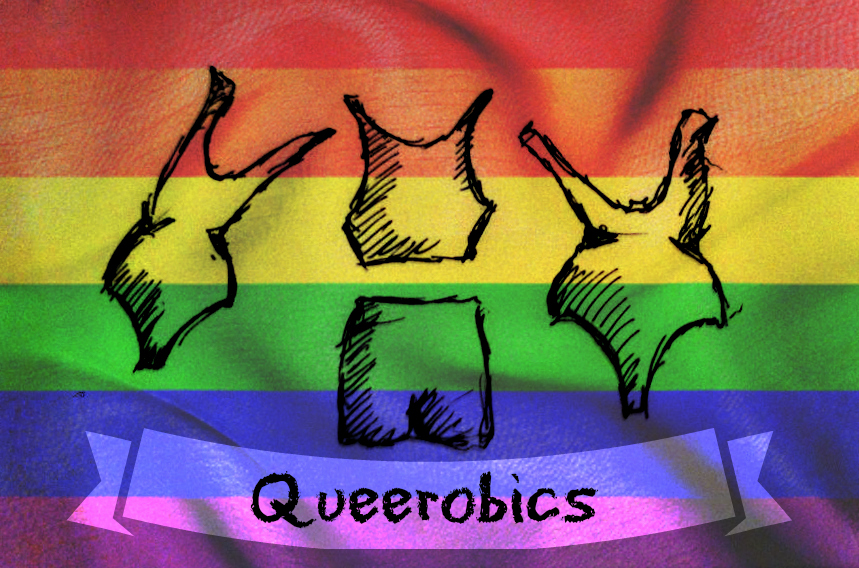Providing safer spaces for physical fitness, Queerobics is a new workout collective with a unique framework. The collective aims to provide inclusive and accessible spaces in Montreal, and its program is already expanding quickly, with three classes a week to choose from this fall.
“[Queerobics] started as free workouts in parks in Montreal over [the] summer, but now Montreal organizations and groups are donating their spaces,” Shannon Herrick, a former McGill student who created the collective in May, explained to The Daily in an interview.
Herrick has an extensive and eclectic fitness background – she’s won a couple of national synchronized swimming championships during her time at McGill, has been a swimming and aquafit instructor, and also has experience with dance and kickboxing. She promotes a holistic approach to exercise, with Queerobics placing the emphasis on helping participants feel good in their own bodies, learn new workout techniques, and get t in a safer space.
Queerobics’ new and positive take on exercising begins with the very locations where the classes take place. The classes are held every second Tuesday in Rats 9, an art gallery that aims to promote alternative points of view “from the margins.” Queerobics also has a weekly spot with Concordia’s Centre for Gender Advocacy, and in a style that’s “very Montreal,” extra classes are given at secret locations every week, with the addresses sent to interested participants via text message.
Herrick runs her classes on a pay-what-you-can basis, with all of the proceeds going back to host spaces like Rats 9 to support their efforts to foster alternative spaces. It’s this relationship between Queerobics and its hosts that Herrick refers to with the slogan “community and muscle building.”
“It’s in the way you approach it – I’ve definitely been in classes where instructors have said things like, ‘Okay ladies, now we’re gonna get fit for our man!’ so that’s where feminist fitness comes in.”
Herrick was prompted to found Queerobics after becoming frustrated with the inherently gendered and often inaccessible nature of mainstream gyms and fitness classes. “I wanted Queerobics to be a tool for people who don’t feel safe in the gym. It’s the easiest changes, like asking participants about their preferred personal pronouns,” she said.
“It’s in the way you approach it – I’ve definitely been in classes where instructors have said things like, ‘Okay ladies, now we’re gonna get fit for our man!’ so that’s where feminist fitness comes in,” Herrick continued.
A typical Queeobics class starts with a “true warm up.” It’s relaxed, with the aim of helping participants feel good in their bodies at that very moment. The class then moves into aerobic exercise, followed by either some high-intensity interval training (peppered with lots of active rest), or a strength-based circuit. It ends with yoga and stretching to help participants ease back into their day. But above all, the class structure is flexible and adaptable.
“I’m constantly asking – is everybody with this?” Herrick explained. She encourages her students to listen to their own bodies and make sure they’re working at a pace that suits them.
While the media’s standards of fitness portrays lean, hard bodies, Herrick understands that health is not about a standardized appearance. “I want to make sure our bodies and minds are healthy,’” she said. For one client, that might mean being able to hold a handstand; for another, it might be completing five modified push ups.
While this way of approaching exercise is beneficial to anyone who wants to foster a healthy relationship with physical activity, it’s particularly important for people who have experienced prejudice and institutionalized discrimination within fitness, sport, and physical education settings. Many such settings, for example, only have changing rooms that enforce the gender binary. Herrick said that some individuals within the LGBTQ community have told her that they’re sick of entering changing rooms and being asked if they’re in the right place.
Herrick explained, “There’s an inherent physicality to it – with physical activity, ‘physical’ is in the title. And if you think ‘physicality’ and go along a tangent, you can come to sexuality and the body, your relation to your body and other people’s bodies. It’s a really complicated issue that’s just so glossed over like, ‘Here’s a gym and two locker rooms!’”
“Because a lot of clients in the queer community have had bad experiences with physical education systems in schools, I try to strike a balance between explaining technique, and being a bit silly,” Herrick said.
Queerobics is also known for having thoughtfully renamed exercises with oppressive or potentially triggering names – “suicides” are called “euphorias.” Participants also get to experience challenging workouts like “Turn down for squat,” set to the hit by DJ Snake and & Lil Jon.
With a refreshing understanding of how deeply connected mental and physical health are, Queerobics was clearly born out of passion. The collective seems on track in its progress toward creating alternative, safer spaces for “accessible, inclusive and absurdly fun fitness.”
Queerobics’s fall schedule is available on their Facebook page. Contact Shanon Herrick at queerobicsmtl@gmail.com if you’re interested in providing a space for classes to be held, fundraising for an initiative via a special Queerobics class, or even helping lead classes.

